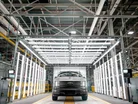Why is Ford Broadening its EV Strategy?

The Ford Motor Company is broadening its EV strategy as it looks to continue to give customers maximum choice and also play to the strengths of the company.
The plan involves updating Ford's vehicle lineup in North America to offer more electric options, making it easier and more affordable for customers to switch to electric vehicles.
Ford will also focus on releasing a new high-tech electric commercial van in 2026, followed by two advanced electric pickup trucks in 2027 as well as other affordable EVs in the future.
Ford has also adjusted its US battery sourcing strategy to lower costs, make the most of its production capacity and support the current and future production of electric vehicles.
Committed to EV innovation
“We are committed to innovating in America, creating jobs and delivering incredible new electric and hybrid vehicles that make a real difference in CO₂ reduction,” said Ford President and CEO Jim Farley.
“We learned a lot as the number two US electric vehicle brand about what customers want and value, what it takes to match the best in the world with cost-efficient design and we have built a plan that gives our customers maximum choice and plays to our strengths.”
Ford is acknowledging the EV market is changing quickly, with Chinese companies gaining more global market share by using cost advantages like controlling their supply chains, cheap engineering, advanced batteries and strong digital features.
Today's EV buyers are also more focused on saving money than early adopters were, choosing EVs to cut down on fuel, maintenance costs and time spent refuelling since they can charge at home.
With many new EV options coming out in the next year and stricter regulations, pricing pressure is increasing. Because of this, Ford says it's crucial for companies to keep costs competitive globally and carefully choose which customers and products to focus on to maintain an eye on profitable growth.
Creating long-term value at Ford
“We’re committed to creating long-term value by building a competitive and profitable business,” said John Lawler, Ford Vice-Chair and Chief Financial Officer. “With pricing and margin compression, we’ve made the decision to adjust our product and technology roadmap and industrial footprint to meet our goal of reaching positive EBIT within the first 12 months of launch for all new models.”
Ford is adjusting its strategy by changing the timing of product launches and rethinking how it sources batteries. The company now plans to use hybrid technology in its upcoming three-row SUVs instead of making them fully electric. Because of this change, Ford will write off about US$400m in non-cash costs related to manufacturing equipment for the all-electric three-row SUVs that it no longer plans to produce.
These changes could also lead to additional costs of up to US$1.5bn, which Ford will report as a special item in the quarter when those costs occur.
Ford's next generation of electric vehicles will start with a commercial van that will be built at the Ohio Assembly Plant in 2026.
Ford is already a leader in commercial electric vehicles, thanks to the E-Transit, which is the top-selling electric van in the US. Commercial customers are switching to electric vehicles faster because they appreciate the lower overall costs and productivity gains that EVs offer. For these customers, vehicles, software and charging solutions are essential tools.
Transforming the design of EV
Ford set up a special team in California in 2022 dedicated to transforming how the company develops its next-generation vehicles and lowering the costs of EVs. This team uses a systems-integration approach, working across design, engineering, supply chain and manufacturing to completely rethink how vehicles are made. Its goal is to simplify the process, reduce costs and dig deeper into the supply chain to ensure Ford can compete with the best in the world on price.
“We recruited the most technically skilled and creative professionals from inside and outside Ford to drive a radical change in how we develop an electric vehicle,” said Jim. “The work of this highly talented team has evolved into a critical enabler of our electric vehicle strategy. These electric vehicles will be lower cost, and not compromised in any way.”
Ford’s battery technology strategy
“An affordable electric vehicle starts with an affordable battery,” Jim added. “If you are not competitive on battery cost, you are not competitive.”
Ford has adjusted its battery sourcing strategy to support both electric vehicles and other new electrified vehicle types. This move aims to reduce costs, improve the efficiency of their investments and ensure the company qualifies for tax credits available under the Inflation Reduction Act.
- Ford and LG Energy Solutions plan to shift some Mustang Mach-E battery production from Poland to Holland, Michigan in 2025 to take advantage of benefits under the Inflation Reduction Act
- The BlueOval SK joint venture's Kentucky 1 plant will begin producing battery cells in mid-2025 for the current E-Transit, with an extended range, and the F-150 Lightning, resulting in significant cost savings and coming online earlier than expected
- In late 2025, BlueOval SK at BlueOval City in Tennessee will start producing cells for Ford’s new electric commercial van, which will be built at the Ohio Assembly Plant. These same cells will also power the next-generation electric truck to be assembled at BlueOval City, as well as future electrified vehicles with emerging technologies. This shared cell strategy gives Ford flexibility in sourcing batteries for various vehicle segments and electrified platforms as the market evolves
- Production of lithium iron phosphate (LFP) batteries is set to begin in 2026 at BlueOval Battery Park Michigan, the first automaker-backed LFP battery plant in the US. This will qualify Ford for Inflation Reduction Act benefits and provide one of the lowest-cost battery cells in North America.
*******************
Make sure you check out the latest edition of EV Magazine and also sign up to our global conference series - Sustainability LIVE 2024.
*******************
EV Magazine is a BizClik brand.


